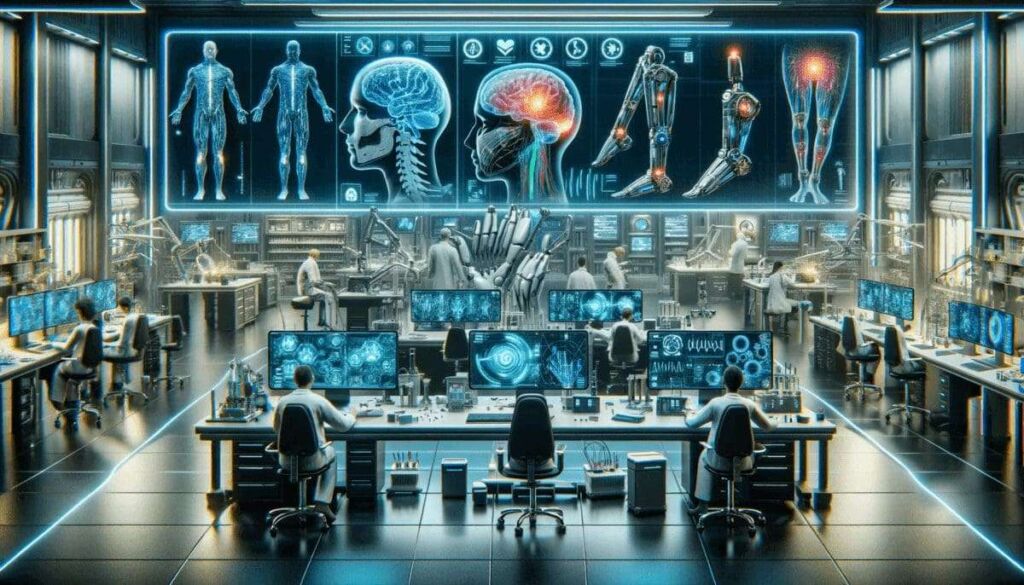Revolutionizing Healthcare: The Future of AI-Powered Biohybrid Systems in Prosthetics, Bionics, and Sensory Augmentation
In the realm of technological innovation, the convergence of artificial intelligence (AI) and human body parts marks a frontier known as biohybrid systems. This emerging field holds the promise of creating seamlessly integrated interfaces between AI and various aspects of the human body, unlocking new possibilities in healthcare, prosthetics, and human augmentation.
Integrating AI with Human Body Parts – AI-powered biohybrid systems
Biohybrid systems represent the pinnacle of technological advancement, where AI intertwines with human physiology. This integration aims to create enhanced functionality and improved quality of life for individuals by leveraging AI’s adaptability and processing power.
Revolutionizing Prosthetics and Bionics
Advanced Prosthetics
The integration of AI with prosthetic limbs and bionic devices represents a remarkable stride towards restoring functionality for individuals with limb loss. Advanced prosthetics, equipped with AI-driven components, can adapt to user behavior, providing a more natural and intuitive experience. These systems learn from the user’s movements, enabling a level of dexterity and responsiveness previously unimaginable.
Enhanced Mobility
AI-powered bionic devices offer improved mobility and autonomy. By analyzing the user’s gait and movement patterns, these devices can adjust in real-time, offering smoother and more efficient motion, significantly enhancing the user’s daily life.
Brain-Computer Interfaces (BCIs)
One of the most intriguing frontiers in AI-human integration is the development of Brain-Computer Interfaces (BCIs). BCIs establish a direct communication pathway between the brain and external devices, facilitating the control of robotic limbs, cursor movements on a computer screen, or even enabling communication for individuals with paralysis. These interfaces hold the potential to redefine the boundaries of human-machine interaction.
Applications of BCIs – AI-powered biohybrid systems
- Robotic Limb Control: Allowing users to control prosthetics through thought, providing a seamless extension of their body.
- Communication Aids: Enabling individuals with severe motor impairments to communicate more effectively.
- Neurofeedback Systems: Enhancing cognitive rehabilitation and therapy through real-time brain activity monitoring.
Sensory Augmentation – AI-powered biohybrid systems
Enhancing Human Senses
AI’s role in sensory augmentation is opening new avenues for enhancing human experiences. Devices that convert visual information into tactile feedback for those with visual impairments exemplify the potential of AI to augment and extend our natural senses. These innovations aim not only to compensate for lost abilities but to enhance the overall human sensory experience.
Practical Applications
- Tactile Vision Substitution: Helping visually impaired individuals navigate their environment using tactile feedback.
- Hearing Enhancements: Improving auditory experiences through AI-driven hearing aids that adapt to different sound environments.
The Era of Smart Implants
AI-Driven Medical Devices
Advancements in medical implants have paved the way for AI-driven devices designed to regulate bodily functions. Implants, such as pacemakers and insulin pumps, have long been integral to managing health conditions. The next frontier involves AI-assisted implants that dynamically respond to changes in the body, optimizing health outcomes and improving patients’ quality of life.
Personalized Healthcare
AI-enabled implants can tailor treatments based on real-time data, providing personalized healthcare solutions that adapt to the patient’s unique needs.
AI-Assisted Organ Transplants – AI-powered biohybrid systems
Improving Transplant Efficiency
AI is also making significant contributions to the field of organ transplantation. From optimizing organ matching algorithms to monitoring post-transplant health, AI technologies promise to improve the efficiency and success rates of transplantation procedures, addressing critical challenges in the organ donation process.
Post-Transplant Monitoring
AI systems can continuously monitor transplant recipients, detecting early signs of rejection or complications, ensuring timely medical interventions and better long-term outcomes.
Challenges and Ethical Considerations
Ethical Concerns
While the potential benefits of AI integration with human body parts are vast, ethical considerations loom large. Privacy concerns, consent issues, and the impact on human identity are complex topics that require careful examination. Ensuring the biocompatibility of AI components with the human body and establishing robust safety measures are critical challenges that must be addressed.
Collaboration and Regulation
In the pursuit of this groundbreaking intersection between AI and human biology, collaboration between medical professionals, engineers, ethicists, and regulatory bodies is paramount. Striking a balance between innovation and ethical responsibility will be key to navigating the uncharted territory of biohybrid systems.
Conclusion – AI-powered biohybrid systems
The integration of AI with human body parts through biohybrid systems is revolutionizing healthcare. From advanced prosthetics and bionics to brain-computer interfaces and sensory augmentation, AI is enhancing and extending the capabilities of the human body. While challenges and ethical considerations remain, the collaborative efforts of various stakeholders will shape a future where humans and AI coexist to create a better quality of life and expanded human potential.
Related Posts:
AI-Powered Banking: Amnon Shashua’s Digital Bank Revolutionizes Finance in Israel
Securing the Future: Navigating the Emerging Challenges of Brain-Computer Interface Security
Envisioning AI-Powered Robots in the Kitchen: Challenges and Ethical Considerations
The Future of Technology: Merging with Our Lives
Interwoven Realms: Unraveling the Connection Between Touch and Time Perception
Top Tools for Ethical hacking in 2024
What’s one of the biggest cybersecurity challenges businesses face?
Helping humans speak to the computer
